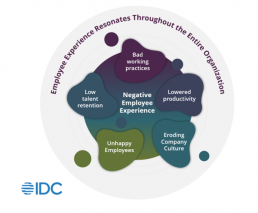The success of any organization is inextricably linked to the experiences of its employees. Positive employee experiences (EX) generate favorable results, contributing to the overall health and success of businesses. Conversely, employee dissatisfaction can cascade through the organization, leading to stagnation in innovation, declining client satisfaction, and reduced profitability. Thus, employee dissatisfaction serves as an early warning sign of deteriorating organizational health.
According to IDC’s latest Future of Work Employee Experience EMEA Survey, 63.6% of employees in the Europe, Middle East, and Africa (EMEA) region are unhappy with their employers. This alarming statistic indicates that nearly two-thirds of businesses in EMEA are vulnerable to the risks associated with poor employee experiences.
Employee dissatisfaction often manifests in suboptimal customer experiences (CX). Happy, engaged employees are more likely to deliver exceptional service, driving customer loyalty and business growth. Therefore, improving EX is a strategic imperative for enhancing CX and achieving sustainable success.
This blog highlights five practices that organizations must avoid in order to prevent the negative domino effect of poor employee experience on business success.
- Reliance on Outdated Technology
Organizations often upgrade their technological solutions to improve compatibility and strengthen security. However, the impact of outdated technology on employee experience is frequently overlooked. When employees are forced to use obsolete systems, their efficiency suffers, leading to frustration and disengagement. This hampers their ability to solve problems creatively, as well as their ability to innovate.
Reliance on legacy systems also increases the likelihood of technical failures, slowing down workflows, escalating operational costs, and eroding the organization’s competitive edge.
- Inefficient IT Support
IT support is the backbone of a well-functioning modern workplace. Inadequate IT support results in lingering technical issues, causing disruptions and prolonged downtimes. This frustrates employees, leading to decreased morale and productivity.
Employees expect prompt and effective solutions to their technical problems. When these expectations are not met, trust in the organization erodes, resulting in higher turnover rates, increased absenteeism, and a general decline in workplace engagement. An underperforming IT department thus becomes a critical vulnerability, impacting overall employee experience, client satisfaction, and profitability.
- Excessive Surveillance and Monitoring
The rise of employee surveillance and monitoring technologies is a double-edged sword. While intended to boost productivity and security, excessive monitoring can severely damage workplace culture. Employees who feel constantly watched are likely to experience heightened stress and anxiety, reducing job satisfaction and productivity.
A culture of surveillance undermines trust between employees and managers, fostering a punitive environment where employees feel undervalued and demoralized. This stifles collaboration and creativity, both of which are essential for innovation. Moreover, a culture of mistrust can tarnish the organization’s reputation, hindering its ability to recruit and retain top talent.
- Insufficient Communication and Productivity Tools
Effective communication is vital to any organization. Insufficient communication tools impede the flow of information, leading to misunderstandings, errors, and delays, which disrupt workflows and diminish overall productivity.
Without robust communication platforms to facilitate collaboration, organizations risk creating silos within departments. Poor communication tools not only hinder day-to-day operations but also stymie strategic initiatives, affecting long-term organizational goals.
- Lack of Structured Training and Development Programs
Top talent across all sectors seek opportunities for personal and professional development. Organizations that neglect employee training and development risk losing valuable talent to competitors offering better development opportunities. Additionally, a lack of training leaves employees ill-equipped to adapt to new challenges and technologies, leading to stagnant growth and diminished innovation.
Employees view training and development as crucial to their career growth. Organizations that invest in their employees are more likely to earn their loyalty and engagement. Conversely, businesses that fail to provide these opportunities face higher turnover rates and reduced employee loyalty, incurring significant recruitment costs and disrupting continuity and team cohesion, further impacting productivity and client satisfaction.
Conclusion
The interdependencies within an organization mean that poor employee experiences can trigger a cascade of negative outcomes. To mitigate these risks, organizations must prioritize employee experience. Investing in employee experience not only enhances organizational health but also drives business success. Organizations in EMEA recognize this: in 2023, 62% of businesses in the region reported that they were investing in employee experience (Source: IDC’s Future Enterprise Resilience Survey, June 2023, n = 1,014).
Addressing these five common areas that cause poor employee experience is a critical step toward achieving better organizational health and overall success.
Find out more about IDC’s research on factors that influence employee experience here.


